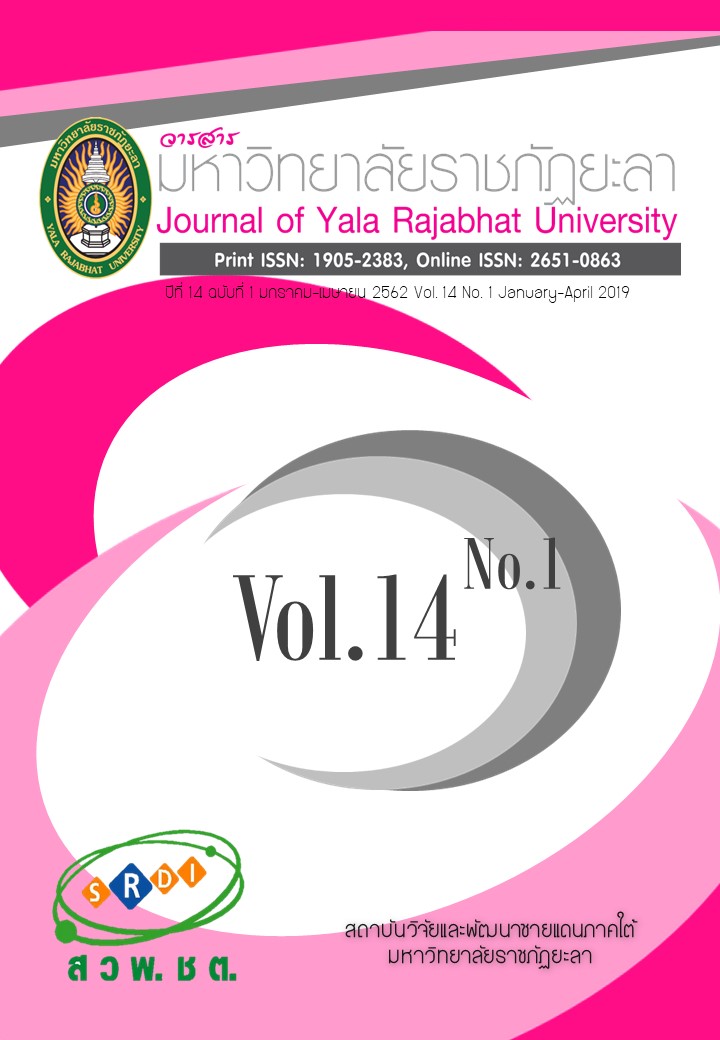การเรียนรู้แบบเชิงรุก : การเรียนโดยใช้ปัญหาเป็นฐานในศตวรรษที่ 21
Main Article Content
บทคัดย่อ
บทความวิชาการนี้มีจุดมุ่งหมายเพื่อนำเสนอกรอบแนวคิด หลักการ และทฤษฎี เกี่ยวกับการเรียนรู้แบบเชิงรุกโดยใช้ปัญหาเป็นฐานที่เหมาะสมกับบริบทในศตวรรษที่ 21 ซึ่งได้จากการศึกษาวิเคราะห์จากหนังสือ ตำรา และบทความต่างๆ นำมาวิเคราะห์ สังเคราะห์ ออกมาเป็นแนวคิดที่สามารถนำไปใช้ในการประเมินผลลัพธ์การเรียนรู้ของผู้เรียน และยังสามารถนำไปประยุกต์ใช้กับการเรียนรู้แบบเชิงรุกด้วยวิธีการสอนอื่น ๆ ได้อย่างมีประสิทธิภาพ เนื่องจากเป็นแนวคิดที่ออกแบบและประเมินตามคุณลักษณะของผู้เรียนตาม VARK Learning Styles ผลการศึกษา พบว่า การเรียนรู้แบบเชิงรุก (Active Learning: AL) และการจัดการเรียนโดยใช้ปัญหาเป็นฐาน (Problem Based Learning: PBL) สามารถใช้เป็นแนวทางในการประเมินผลลัพธ์การเรียนรู้ของผู้เรียนแบบการเรียนรู้เชิงรุก โดยใช้การเรียนโดยใช้ปัญหาเป็นฐานซึ่งเป็นการส่งเสริมทักษะแห่งศตวรรษที่ 21 ให้แก่ผู้เรียนได้อย่างมีประสิทธิภาพ
Article Details
บทความ ข้อมูล เนื้อหา รูปภาพ ฯลฯ ที่ได้รับการเผยแพร่ในวารสารมหาวิทยาลัยราชภัฏยะลานี้ ถือเป็นลิขสิทธิ์ของวารสารมหาวิทยาลัยราชภัฏยะลา หากบุคคลหรือหน่วยงานใดต้องการนำทั้งหมดหรือส่วนหนึ่งส่วนใดไปเผยแพร่ต่อหรือกระทำการใดๆ จะต้องได้รับอนุญาตเป็นลายลักษณ์อักษรจากวารสารมหาวิทยาลัยราชภัฏยะลาก่อนเท่านั้น
เอกสารอ้างอิง
2. Dahsah, C. (2009).15 techniques in active learning. The Institute for the Promotion of Teaching Science and Technology : IPST, 38(163), 72-76. (in Thai)
3. Felder, R. M. & Brent, R. (2009). Active learning: An introduction. ASQ Higher Education Brief, 2, 4-9.
4. Fleming, N. D. (2007). VARK: A Guide to Learning Styles [Online]. Retrieved 2017 December, 8, from: http://www. learningreviews.com/Learning-Styles-Challenges/ Learning-Styles/ VARK-A- Guide-to-Learning-Styles.html.
5. Khamanee, T. (2013). Teaching science. Knowledge for effective learning processs. (17th ed.). Bangkok: Chaulalongkorn University Printing House. (in Thai)
6. Lekhakula, A. (2008). Problem-based learning. Songkhla: Faculty of Medicine Prince of Songkla University. (in Thai)
7. Makmee, P. (2008). Problem-based Learning. EAU Heritage Journal, 5(1),7-14. (in Thai)
8. Meyers, C. & Jones, T. B. (1993). Promoting Active Learning: Strategies for the Collage Classroom. San Francisco: Jossy Bass.
9. Panich, W. (2012). 21st Century Learning Path for Disciples. (4thed.). Bangkok: Tathata Publication. (in Thai)
10. Nilmanee, T. Phonak, D. & Sintanakul, K. (2016). The Classification of VARK Learning Style of Computer Engineering Students of Rajamangala University of Technology PhraNakhon. Journal of Yala Rajabhat University, 11(2),145-158.
11. Plianbumroong, D. & Utaipan, P. (2016). Understanding and Opinions towards Problem-Based Learning among Nursing Students and Nurse Instructors in Boromarajonani College of Nursing, Yala. The Southern College Network Journal of Nursing and Public Health, 3(2), 39-52. (in Thai)
12. Pochanukul, P. (2009). From Active Learning to Action Research. Pattani: Faculty of Education Prince of Songkla University Pattani Campus. (in Thai)
13. Pruettikul, S.(2012). Quality of students driven from active learning process. Buraphab University, Journal online,6(2), 1-13. (in Thai)
14. Rogers, C. R. (1969). Freedom to learn. Columbus: Charles E. Merrill Publishing Co.
15. Rueangsuwan, C. (2010). A design and development of courseware and web-based learning. (14th ed.). Department of Technology and Communication for Education, Faculty of Education, Mahasarakham University, Mahasarakham. (in Thai)
16. Satayasai, W. (2004). Problem-Based learning the learner-centered learning model is Central. Bangkok: Book net. (in Thai)
17. Srimala, S. & Wangruangsatid, R. (2015). Achievement and Satisfaction of Nursing Students Studying Newborn Nursing Care by Using VARK Learning Style. Journal of Health Science, 24(4), 751-759.
18. Suthirat, C. (2012). 80 Innovation-oriented learning management. Bangkok: Danex Intercoperation. (in Thai)
19. Woods, D. R. (1994). Problem-based learning: How to gain the most from PBL. Hamilton: Woods Publisher.


